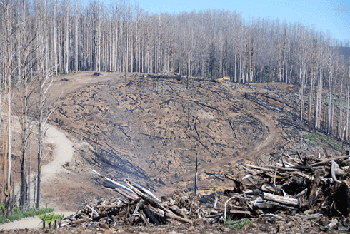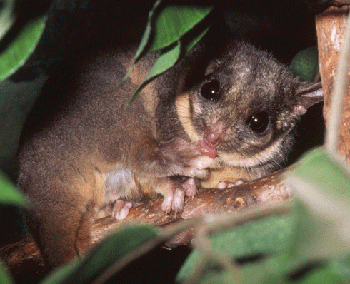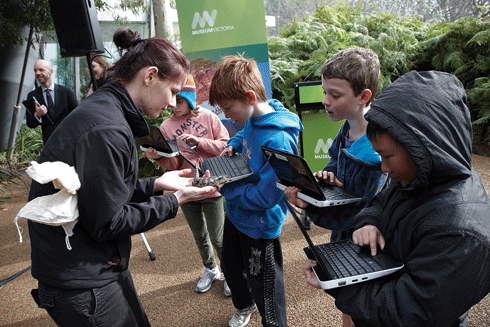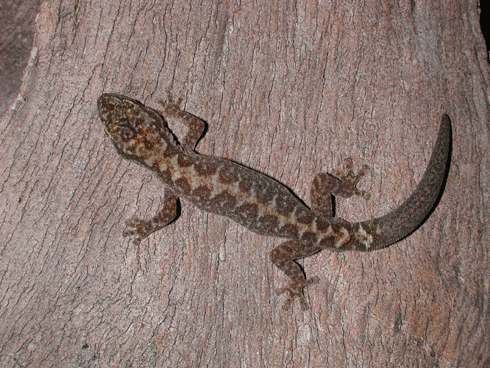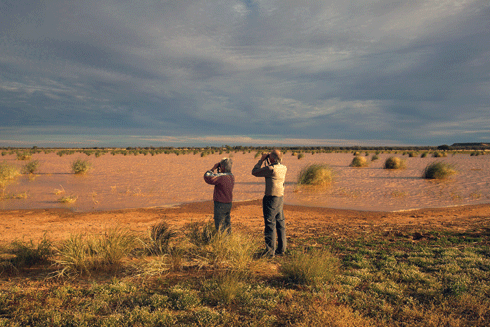
|
Published: 25 October 2010
After the fire: Leadbeater’s long journey
Life is slowly returning to the wet mountain ash forests burned in Victoria’s 2009 Black Saturday fires. Yet, the future of these forest communities – symbolised by the iconic Leadbeater’s possum – is by no means guaranteed, warns a group of ecologists in their compelling new book, Forest Phoenix.
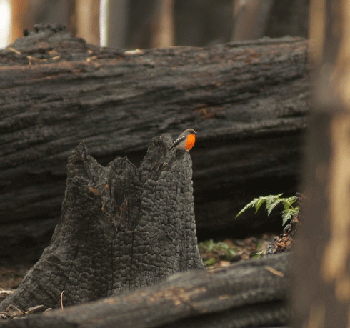
|
|
The orange flash of the Flame Robin is now a common sight in charred Montane ash forests. Credit: David Blair
|
Montane ash forests are truly spectacular, and contain the tallest flowering plants in the world. Some of the world’s most enigmatic and iconic animal species, of which several are threatened or endangered, are also found in the Central Highlands of Victoria. For example, virtually the entire known distribution of the nationally endangered Leadbeater’s possum, one of the state’s faunal emblems, occurs in the montane ash forests of this region.
Animal population recovery after fire, whether it commences through survival or recolonisation, is intimately tied to the structure and recovery of the plants in the forest. In the long term, the death of and damage to standing trees resulting from wildfires can stimulate the development of hollow tree cavities. These hollows are essential habitat for many animals, and are most likely to form in large trees.
Standing, burned large trees that contain hollows can make a regenerating stand suitable for Leadbeater’s possums within 10 years of a fire. However, burned young forest that does not contain these biological legacies will not provide suitable habitat for Leadbeater’s possums for the 100–200 years that it takes for mountain ash trees to mature and begin to form hollows.
The prevalence of trees with hollows in a recently burnt stand is dependent on a number of factors, including:
-
the age of forest at the time it was burned – more large hollow-bearing trees occur in an old-growth stand than in young forest
-
whether the trees were alive or dead immediately before the fire – dead trees are far more susceptible to being fully consumed by a fire than living trees
-
the severity of a fire – a high severity fire will remove all large dead trees in a stand.
Large areas of montane ash forests have been logged for the production of pulp and timber, which also decreases the available Leadbeater’s possum habitat. About 75–80 per cent of ash-type forest in Victoria’s Central Highlands region is broadly designated for wood production.
|
The lead author of Forest Phoenix, Professor David Lindenmayer, has a long history of studying the wet montane forests of Victoria’s Central Highlands, which began with field studies of Leadbeater’s possum 27 years ago. Since then, his research career has led him to investigate the broader biodiversity of these forests, and the impacts of fire ecology, logging impacts and climate change. |
‘A lot of the research has got to do with understanding how the system works – with forest pattern and ecological process,’ Prof. Lindenmayer says. |
He is sceptical about the public perception that prescribed burning of wet montane forests will protect them from intense wildfires in future. |
‘It’s important that we realise that infrequent, intense burning is the kind of fire system this forest has evolved with over the past 20 million years,’ he says. ‘Any burning of a young regenerating forest comprised of trees less than 20–30 years old risks killing all of the trees and losing the forest altogether, along with the myriad of plant and animal species associated with it. Prescribed burning also accelerates the loss of hollow trees; old hollow tree cavities and dead wood are more likely to burn faster.’ |
Lindenmayer says the message in Forest Phoenix is one of hope – that the magnificent montane ash forests are recovering, despite the scale and intensity of the 2009 fires. |
And while he holds out some hope for the future of Leadbeater’s possum, much will depend on the timing and intensity of the next fire, and whether the recovering areas are disturbed by logging. |
‘If we don’t salvage log those areas, particularly old forests, Leadbeater’s possum as a species may make it through. But we must remember, it’s got the cards stacked against it – 80 per cent of its distribution is in areas broadly designated for logging,’ he says. |
More information: |
Lindenmayer D, Blair, D, McBurney L and Blair, D (2010). Forest Phoenix: How a great forest recovers after wildfire (2010) CSIRO Publishing, www.publish.csiro.au/pid/6426.htm |
The traditional kind of logging in montane ash forests is clearfelling. Of the areas of montane ash forest subject to logging, more than 95 per cent are clearfelled. Under this method of cutting, virtually all standing trees are removed from a 15–40 hectare area in a single operation, leaving few live standing trees.
Clearfelling has been a highly controversial form of logging in Australian forests, in part because of its impacts on values such as biodiversity conservation. In particular, it either removes the majority of large old trees from a stand, or rapidly accelerates the decay and collapse of those large trees that are retained. These key attributes of forests do not redevelop in a harvested area for a century or more.
Clearfelling is also the typical form of post-fire salvage logging in montane ash forests. The forests therefore undergo a double set of disturbances – wildfires followed by logging.
Salvage logging is common after major disturbances such as the 2009 wildfires, and aims to recover some of the economic value of fire-damaged trees. Ecologically, however, dead trees created by a fire are important and valuable biological legacies. Salvage logging removes most of the standing timber, and the forest that regenerates is a single age class. In contrast, a burnt forest that is not salvage logged will develop a complex structure composed of young regenerating trees plus living and/or dead trees remaining from the previous stand – ideal habitat for species such as Leadbeater’s possum.
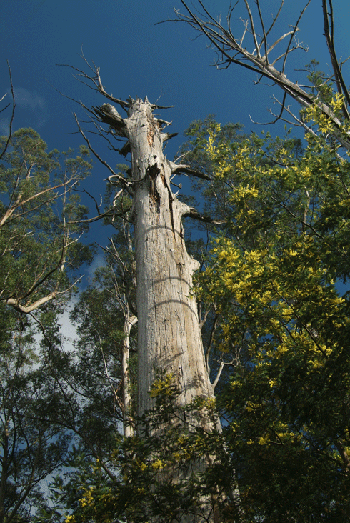
|
|
A classic hollow ‘stag’ tree favoured by Leadbeater’s possum: this tree was killed in the 1939 Victorian fires and has remained standing for more than 70 years. Credit: David Blair
|
Recent research has attempted to develop alternative logging methods to clearfelling that better retain the key features of forests needed by biodiversity. One method showing some promise involves the retention of islands of forest within cut blocks of forest, creating a combination of old trees and regrowth forest, or ‘multi-aged’ forest.
Multi-aged montane ash forests are very important environments for a range of species; for example, they contain the highest species diversity of arboreal marsupials. Therefore, the island-retention method of logging is more likely to retain suitable habitat for a number of key species in montane ash forest, including Leadbeater’s possum.

|
|
The loss of significant stag trees in the 2009 fires led to the establishment of a nest box site for Leadbeater’s possums in snow gums on Lake Mountain. Credit: David Blair
|


